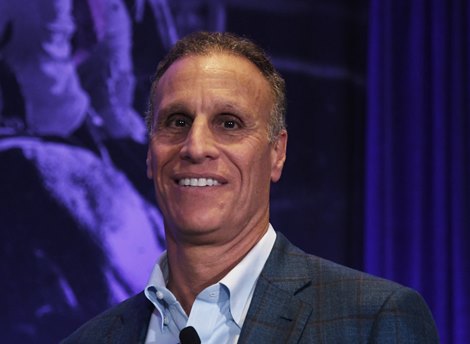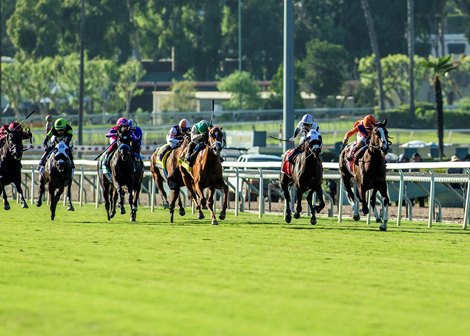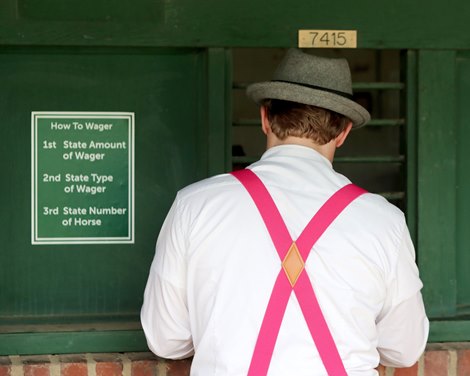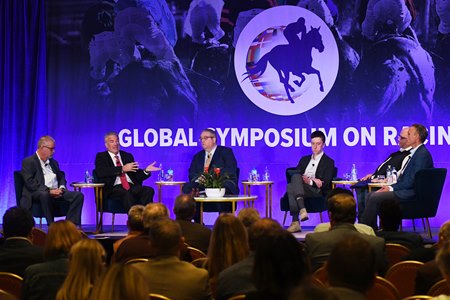In the wake of a new round of criticism of computer-assisted wagering, we talked with Elite Turf Club president Scott Daruty about CAW and the concerns of traditional players.
Elite Turf Club is owned by prominent track owners The Stronach Group and the New York Racing Association. TSG owns 80% of Elite while NYRA owns 20%. Of course, both of those track owners also own prominent advance-deposit wagering outlets as well, in TSG's XpressBet.com and NYRA's NYRABets.com.
Daruty answered BloodHorse questions on CAW by email and then Frank Angst conducted some follow-up questions (as differentiated). It should be noted that the discussion was completed before Elite was named as a defendant in a lawsuit contending that CAW breaks racketeering laws, although it's unlikely Daruty would have commented on ongoing litigation. BloodHorse plans continued coverage of that litigation.
BloodHorse: For those who might not know, can you explain what CAW wagering is?
Scott Daruty: The term "CAW" stands for Computer-Assisted Wagering. Industry simulcast agreements typically define the term as a wagering process pursuant to which a wagering customer: accesses tote information in an electronic format using a computer, utilizes a computer to formulate, or assist in formulating, wagers using such electronically delivered tote information, places the wagers in a manner commonly referred to in the horse racing industry as "batch streaming" or "batch wagering," and submits more than six wagers per second.
In today's digital world, any player who bets through an ADW company has the ability to bet in a manner that satisfies the first three elements of the definition. Therefore, the true distinguishing feature of a CAW player is the ability to place more than six wagers per second.

Elite Turf Club is a CAW wagering platform, which means Elite has CAW customers who wager through Elite into the pools of racetracks in the United States and abroad. But with technological advances that have taken place in recent years, all major ADW companies (such as TVG, TwinSpires, and XpressBet) have the technical ability to have customers wager at over six bets per second.
Once the CAW definition is triggered for a wagering customer, the customer must satisfy the following requirements: a thorough vetting process including initial and ongoing background checks as well as source of funds verification, a separate TRA code through which all wagers are tracked, an absolute restriction on canceling wagers, and the requirement (for Elite customers) to develop an application programming interface that communicates with the AmTote hub—from which the wagers are sent by (TSG-owned) AmTote to the respective host pari-mutuel pools via industry standard protocol, which is necessary because Elite does not maintain a consumer-facing Graphical User Interface.
BH: How long have the CAW teams been wagering in U.S. pools? How much has their handle increased over the years?
SD: CAW play has been part of the North American horse racing industry for at least 20 years. It is hard to say exactly how much it has grown over the years, because until 1/ST and NYRA took over Elite, there was not the transparency that there is today. CAW players used to wager through a large number of outlets, and they didn't all play by the same rules or have their handle individually tracked. Therefore, it used to be impossible to know exactly how much CAW handle there was.
Because Elite is now owned by two major racing companies, policies and safeguards have been put in place, such as requiring each CAW player to have a unique TRA code, that make it much easier to understand CAW play and its impact on the pools. This gives the tracks the ability to implement appropriate policies such as host fee increases designed to keep CAW wagering in line with the host track's desires.
We do know that CAW play has grown over the past five years or so as new CAW players have entered the market. But many racetracks have increased their host fees to CAW players over that time period in an effort to maintain the appropriate balance between CAW play and non-CAW.
BH: How much money are these groups wagering and what percentage is it of the overall pools?
SD: Elite Turf Club will not accept a "group" as a customer. Each customer of Elite is a single natural person, or a single member domestic limited liability company.
As far as the percentage of the pari-mutuel pools made up by CAW wagers, each racetrack makes its own determination of what it believes is an appropriate percentage. Using Santa Anita Park as an example, Santa Anita believes having approximately 20% of its parimutuel pools come from CAW customers is an appropriate percentage.

Actual wagering data from one full year of racing from July 1, 2024, through June 30, 2025, shows that, over that time period, CAW play was 22.9% of the Santa Anita pools. But CAW was only 11.2% of the win pool, due to an exceptionally high host fee of 11.75% charged by Santa Anita on win pool wagers by CAW players. This highlights the fact that the percentage of CAW in a pari-mutuel pool can be controlled by the host track through the host fee that it charges.
BH: Can you describe how rebates for CAW players work and the percentages involved? Of a million dollars wagered, how much is going to the track, horsemen (purses), and back to the CAW player? How does this compare to other simulcast wagering channels such as casinos, OTBs, and ADW?
SD: The answer varies widely depending upon the racetrack and the pool. To continue using Santa Anita as the example, Santa Anita charges CAW platforms such as Elite the following host fees depending upon the pool:
- 11.75% for win
- 8.25% for place and show
- 10.75% for Pick 6
- 8.75% all other pools
This is far more than is paid to Santa Anita and its horsemen on wagers by betting customers at casinos, OTBs or most other betting locations. These fees are, with some minor exceptions, split 50/50 between Santa Anita and the Thoroughbred Owners of California for all wagering channels—OTBs, casinos, ADW, and CAW. So $1 million wagered by CAW players into the win pool would generate $58,750 for purses and $58,750 of track commission for Santa Anita.
During Santa Anita's autumn meet in 2024, CAW players wagered $2.64 million into the win pool. However, during the 2025 Santa Anita Park autumn meet less than $75,000 was bet into the win pool due to the implementation of a 2-minute win pool restriction demanded by the TOC.
CAW players wagering into the win pool at Santa Anita do not receive a rebate of any material size. (This is because their wagers are subject to an 11.75% host fee against a takeout of 15.43%, plus there are expenses for tote and for Elite's costs.) Also, there is no need for CAW players to use batch betting in the win pool because each player typically only bets two or sometimes three horses in a win pool, and there are no combinations needed. So it is unclear exactly what the win pool restriction was intended to address other than keeping winning players out of the pool, which seems great for the remaining players in the pool, until you realize that there will be a new group of winning players to emerge—are they also then asked to leave?
Late odds shifts are frustrating to everyone, including CAW players. But they are becoming more and more of a reality as more and more horseplayers shift to online wagering. Even customers physically located at a racetrack no longer have to walk to a mutuel window, stand in line, and get their bets down early in order to avoid being shut out. Customers can now stay in their seats and bet at the last moment using a traditional ADW account. As a result of the shifting manner in which horseplayers get their bets down, an ever-increasing percentage of the pari-mutuel pools now come in during the last 60 seconds—or even the last 30 seconds—before the gate opens.
During a one-year period of Santa Anita data studied (July 1, 2024, through June 30, 2025), the average amount of handle in the last 60 seconds coming from CAW players in each race was 30%. That means that 70% of the late money was from non-CAW players. So CAW players certainly contributed to the late odds shift, but they were not the sole cause. This fact is borne out in the experience of the recently completed Santa Anita autumn meet. As stated above, there was virtually no money wagered by Elite customers in the Santa Anita win pool this meet. But in 15% of the races at Santa Anita's autumn meet, the price of the winning horse dropped by 10% or more in the last 30 seconds before the pool closed—with virtually no CAW money in the pool.
In some respects, technology has caused the issue of late odds shifts because advancements in online wagering now allow so much money to come into the win pool in the last 60 seconds. So we need to look to technology for solutions. AmTote now updates its tote odds every 10 seconds as the race nears, which helps to smooth out the changes in odds. But other tote companies are still sending their data into the pools on 30-second cycles. This is certainly one area for improvement.
BH: How is the growth in CAW impacting everyday players? If CAW players are winning—and betting at these amounts—it seems that other players have to be losing at increased rates?
SD: The impact of CAW players on the other players in a parimutuel pool is a mathematical function of the percentage of the pool that is CAW and the CAW win rate. If a pool with a 20% takeout is 20% CAW play and 80% retail play, and if the CAW win rate is 90%, then the theoretical takeout increase on the retail play is an extra 2.5%. But that assumes all retail players are equal, which we know is not the case. Even before CAW players came on the scene, there were "advantage" horseplayers who made money in the pools by beating the average retail player. These advantage players gathered and analyzed data that the average retail player didn't have the time or resources to utilize. This superior data analysis gave these players an advantage that they used to wager at a profit at the expense of the true retail player. So the true retail player has always been subject to a slightly higher takeout caused by better horseplayers.
We believe that the XpressBet retail ADW platform is a good proxy for the purposes of studying the general retail horseplayer. We have studied the win rate of the entire XpressBet customer base over the past 10 years—a time period that generally coincides with an increase in CAW play; at least to the extent CAW play is now visible and trackable, whereas it once was not.
Over the past 10 years, the aggregate win rate—cashed tickets divided by total wagers—of the entire XpressBet retail customer base, when measured quarterly on a rolling four-quarter basis, has trended down by 1.6%. In other words, the aggregate win rate of all XpressBet retail customers combined during the most recently completed four calendar quarters was 1.6% less than the aggregate win rate of all XpressBet retail customers combined during the four quarters of calendar year 2016.
The actual 1.6% win rate decline over the past 10 years is consistent with the theoretical mathematical calculation of 2.5%, after adjusting such theoretical calculation downward slightly to reflect the fact that some CAW play—along with many advantage players—already existing in 2016 so already impacted the Xpressbet retail customer base to some degree.
The advantage players usually have a larger bankroll, bet materially more than average, and often receive rebates or other incentives from racetracks and/or ADW companies. So removing CAW players from the parimutuel pools doesn't necessarily mean the average retail player will win more. To use an analogy, suppose you are playing poker at a table with eight people and you are in the bottom half in terms of skill and experience. How much more money will you win over an extended period of time if the best player gets up and leaves the table? The answer is you won't really do any better; you'll just lose your money over time to the new best player at the table.
BH: Where are these CAW players actually based? I thought there was an effort several years ago to bring them onshore?
SD: The majority of the players are based internationally. The U.S. racing market is not the only market in which these players are active. Many of them wager into the pari-mutuel pools in Hong Kong, France, Australia, Latin America, the UK, and elsewhere.
I believe the effort you are referencing was the effort made by 1/ST and NYRA to ensure that all CAW players are wagering through identified CAW platforms and required to have their own unique TRA code. This effort has been successful and allows us to now have full transparency into the CAW market.
BH: How important is CAW to tracks and purses? Is this especially true in states without added gaming to support purses and tracks, such as California?
SD: The purse money generated by all wagering activities, including CAW players, is vitally important to the California racing industry. California racetracks do not have alternative sources of revenue, such as casinos or historic horse racing, and are therefore struggling to compete with racetracks in other parts of the country that have such revenue streams. As mentioned above, wagering by CAW players contributes more money to purses and tracks on a dollar-wagered-for-dollar-wagered basis than just about every other type of simulcast wagering activity.
To highlight the financial impact of CAW wagering, we can examine the recent Santa Anita autumn meet. As mentioned above, the new win pool restriction at Santa Anita resulted in a decrease in CAW wagering in the win pool of approximately $2.6 million. Overall, CAW wagering at this meet declined nearly $8.5 million. That loss of $8.5 million of CAW handle resulted in the loss of approximately $750,000 of host fee revenue over 16 days of racing. The loss of nearly $50,000 per race day was quite detrimental to the autumn meet, but it will be catastrophic if it continues for the entirety of the Santa Anita winter meet.

BH: What regulator or regulators are ensuring that wagers are arriving before the gates open? How much does this regulation cost Elite each year?
SD: The wagering pools at a host track—such as Santa Anita—close simultaneously for all guest locations (racetracks, casinos, OTBs, and ADW companies) wagering into those pools. It is not possible for any player, including any Elite player, to place a wager after the pools have closed. AmTote possesses detailed time-synchronized transactional logs and Inter Tote System Protocol logs between its respective guest hubs and host racetrack hubs, archived indefinitely. AmTote can clearly demonstrate the time that each wager transaction was received and validate that it was before the time of the stop betting command. The only time any player would be able to wager after a race starts is the extremely rare circumstance where the wagering pools for a race fail to close due to human error. In that circumstance, the wagering pools would remain open for all guest locations until the error is rectified.
Neither Elite nor any other simulcast wagering location pays for the regulators or track stewards directly. But all simulcast wagering locations, including Elite, do pay a host fee to Santa Anita as described above, as well as a tote fee and/or interface fee to cover the cost of the totalizator.
Follow-up questions from Frank Angst
FA: There's been so much success marketing CAW. Are there ideas out there on how to better market to new players and traditional players that have been doing this for a while? It seems like that's where the challenge lies.
I base that on we saw about a 12% bump in pari-mutuel handle on U.S. races during the Covid year, which was unique circumstances. I was hoping that once people gave it a chance, that they would stick with it. Instead, we've seen about a 3% drop in each of the last two years, and we might see a similar decline this year. And I'm not even bringing inflation numbers into it, which would probably make it worse. That's a long way of asking: Are there people thinking about how to better market to the traditional players?
SD: Definitely, people are thinking about that. That is not my particular role in the organization, but there are a lot of people who are I can tell you. I've been in this business now for, you know, well over 20 years. And in the entire time, we've been having the discussion about how do we market to new players, and how do we bring in a younger, younger demographic? I wish I had the answers for those things, but I don't know that there's a silver bullet.
I do think the quality of racing is important and something we have to focus on. I'm from California, so I recognize how our fields are short, and that doesn't present great betting opportunities sometimes when you have a five-horse race, so it's troubling to see that the foal crop continues to decline, meaning we have fewer horses in the system, meaning (smaller) field size. You know, it's hard to hard to keep the field size level up.
BH: The win rate decline using the XpressBet data was interesting to me. I do have to say that I've looked at some on-track wagering and what the effective takeout is for those players. It's very concerning. In Kentucky at the Churchill Downs September meet, the effective takeout rate for on-track players was over 28%. At Kentucky Downs, the on-track effective takeout was over 32%. Do you think CAW is impacting that?
SD: I don't believe that is an accurate cross-section of our industry. I say that because I'm not super familiar with those exact (pools) that you just referenced. But I will make an assumption, and you can tell me if this is a bad assumption.
I'll assume it's like most meets where you have a lot of people on-track who are betting through the windows. They tend to be more casual fans—they go to the races once or twice a year. It's a, 'Let's go with our friends and enjoy a day at the races and have a nice lunch' group of fans.

They're betting through the windows. And to the extent there are more sophisticated players actually at the track, I would be willing to bet that a lot of those players are betting through an ADW account while they're at the track. So I think looking at the numbers through this window is a little bit misleading in that you're getting a snapshot of the least sophisticated and, by the way, probably the least takeout-sensitive part of our market.
I believe in the data we collected from XpressBet, which is a very large ADW company; you're talking about a billion dollars worth of handle across a large cross-section of people across the entire country betting on all different sorts of content. So we think that's a really good proxy. There's no way to know exactly what all retail players in the entire country are doing, but we think looking at that Xpressbet slice is a real good proxy for the whole market.
FA: A thought that's bounced around in my head is that the CAW outlets are betting billions of dollars, and I feel like most of the oversight is coming from entities that have an interest in the success of that. So basically, the tracks and the actual CAW outlets that are handling those wagers are also overseeing all of this. Is there a need for independent oversight?
SD: I don't think there's a need for more independent oversight. I also don't have any objection to more independent oversight. I think if you look at racing throughout history, the tracks have always conducted the wagering from the time there was no simulcast at all and the only bets that were taken were taken at the track. It was the track that operated the wagering, that manned the pari-mutual windows.
As OTBs developed—there's a few markets that are an exception—but for the most part, OTBs were owned and operated by the racetracks, and then ADW developed. And as you know, three of the four major ADW companies are owned by racetrack companies. So I think it makes sense in the pari-mutuel environment in racing that the tracks be the operators of the wagering, because that's how it's always been.
So I don't think there's a need for more oversight, but there's nothing to hide. The facts are the facts, and we certainly don't object to more oversight. In my personal opinion, we are in a much better place today, with the CAW platforms being owned by the racing companies, than we were previously, when the CAW platforms were not owned by the racing companies.
FA: Why has that been a positive shift?
SD: We have the ability to maintain what we believe is an appropriate balance. We have the tools—primarily the host fee. We have the tools we can use to maintain that balance. Now, every racetrack can decide for itself what that balance is. A track might say, I don't want more than 15% of my pool to be CAW, and another track might say, 'Well, I'm OK with 30% of my pool.' I don't feel like it's my job to tell racetracks what they should or shouldn't want for Santa Anita, Gulfstream Park, for the tracks within the Monarch (Content Management) portfolio. I certainly have input on that decision, and we think 20% is a pretty good place to be.
FA: Following up on your comments earlier about poker, which is another gambling pursuit in which players compete against one another instead of against the house, I feel like there's a number of humans that are never going to be comfortable competing against 'algorithms,' against computer players. Is there any way of addressing that, or is it just a case of people are going to either get comfortable with it or they're not?
SD: Well, one of the things that I think is important is to really understand what we're talking about when we're talking about CAW players. What does that mean, really, and in today's world, where you can bet on your phone and you're receiving all the information digitally from your ADW company? You can ingest that information as a regular person, but you certainly don't think of yourself as a CAW player, right? No, you're just a regular guy, but you have the ability—using whatever platform you bet on—to ingest that data, to feed it into something as simple as an Excel spreadsheet, or more complex, if you choose to do that.
I shouldn't say all platforms because I'm not familiar with every single one, but the major betting platforms in the U.S. all have the technology that, if you want to do that, you can do that. You can turn around and formulate your wagers using whatever parameters you want within something as simple as an Excel spreadsheet or something more complicated—like a program you write yourself and then turn around and have those bets placed back in through your TVG or TwinSpires or XpressBet account. You have the ability with technology today to do that at more than six bets a second, although our contracts with those entities say if somebody is at more than six bets per second, that person is now defined as CAW, and goes into a different category and has to follow all these rules.
So it really is something that's available to everybody. I fully acknowledge and understand that most people, myself included, don't have the expertise, or frankly, probably the time, to do it that way.
FA: I've written before that one of the ways to address CAW concerns of traditional players is to put more of this technology into people's hands if they want to take advantage of it. So that's good to hear. California has landed on accepting CAW players as 20% of pools. I like that all sides have thought about that and negotiated that rate. Is this rate always just up for debate? How do entities land on what that number should be?
SD: (France's) PMU sets it at 11%, which seems like kind of a random number to me, but the PMU had targeted that. It's just a decision for each track to make based on what its goals are. I think the PMU being at 11% is low. And I think a lot of that is politically driven. I think they have a lot of the same, how should we say it, 'consumer input?' as we're seeing on Twitter right now?
I think you have to be careful. I think that a lot of the push to restrict CAW players is coming from advantage players who themselves historically were the ones making money, or at least doing better than average. And so we're taking money away from that retail player. They're not necessarily the big fish in the sea anymore, and I don't blame them for trying to get the big fish eliminated, so they will be the big fish again.
It all depends on how you define the term retail player, right? So how are you defining that? Well, I think you have three distinct categories. You have the CAW player. You have the average retail player who's the regular guy with an XpressBet account, or the regular guy at the track—maybe with his wife and kids and having lunch and betting, right? And you have a group of advantage players. These are guys who have speed figure numbers named after them, or sold tip sheets historically, or are very active in the industry. Sometimes it's trainers or owners or people who have always been better handicappers. They put more time and energy into developing their own data, their own angles on races, and have always done better than the average retail player.










